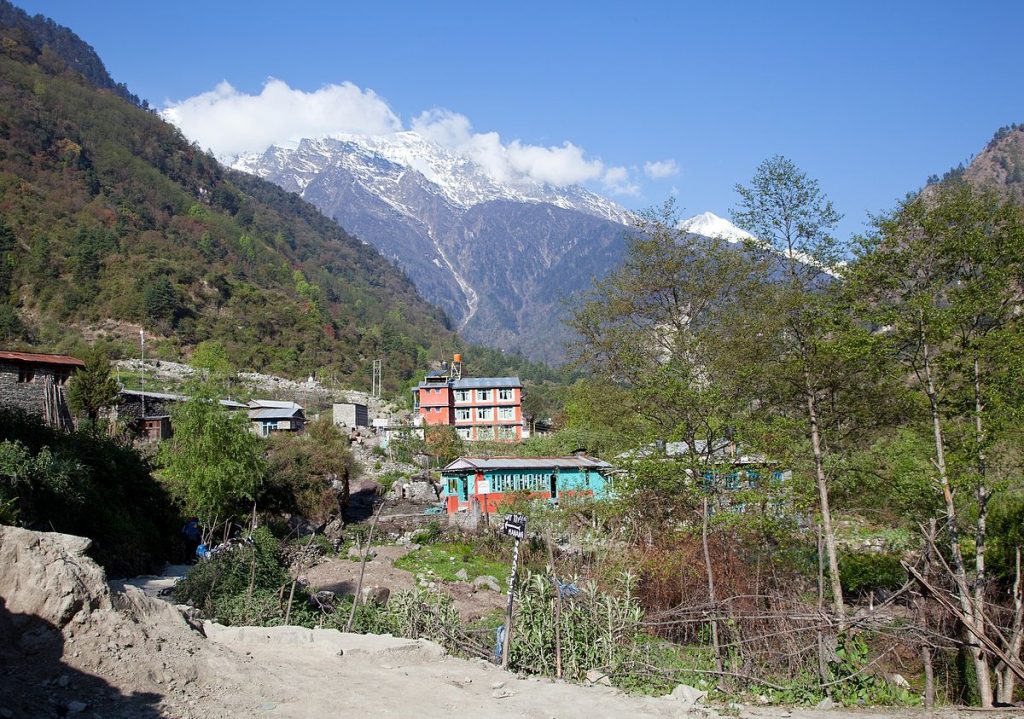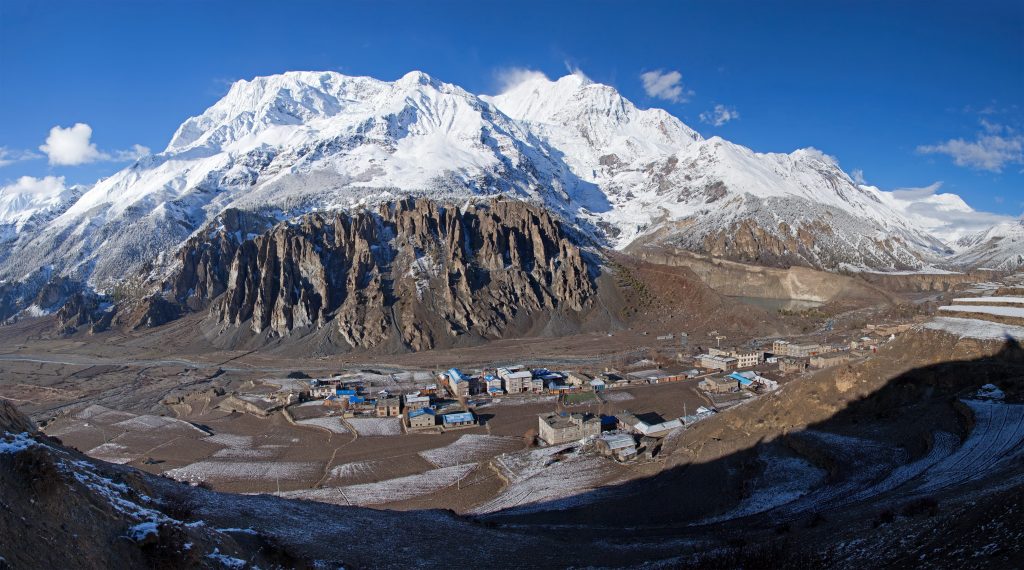Tilicho Peak Expedition is one of the most thrilling and adventurous trips in the Manang valley of Nepal. This trip lets you enjoy the wilderness of nature with the beauty of the culture and tradition of people living there. Tilicho Peak Expedition is the most favourable trip of the country as it comprises all the aspects of the Annapurna region and Manang Valley. Tilicho Peak is the highest point of the Great Barrier which links Khangsar Kang (7,458m) and Nilgiri North (7,061m) together.


It was first climbed by a French expedition led by Emanuel Schmutz in 1978 via the North West Shoulder. In 1950, Maurice Herzog and his team reached the Tilicho Pass in the hope to locate elusive Annapurna I. To their surprise, they found before them a gigantic wall and a big frozen lake (Tilicho Lake) standing on their way to the mountain. This wall was given the name “La Grande Barriere” or “the Great Barrier” by Herzog. Here’s how he described it in his book “Annapurna”.
Tilicho Peak is situated in the high Himalayan region of Manang. Tilicho Peak is the highest point of the Great Barrier that links Khangsar Kang at 7,558 m and Nilgiri North at 7,061 m. The French Expedition team was the first to ascend the Tilicho Peak via the North West Shoulder. An expedition led by Emanuel Schmutz in 1978. Though Tilicho Peak Climbing is exciting and challenging. We will have an opportunity to explore the highest lake on earth. That is Tilicho Lake at 4,920 meters. Tilicho peak Expedition is considered difficult and challenging. Hence, previous experience of peak climbing and good physical fitness is very crucial for the successful climb of Tilicho Peak. Probably, this expedition is a perfect option of adventure-seeking climbers to gain the ultimate climbing experience of Tilicho Peak. While exploring the natural wonders of the Manang region.
The trekking starts with the ride from Kathmandu to Jagat which is about 8 hours. This ride gives you some insight of the rural people; their lifestyle and their culture.
The walk begins on the rocky trail following the Marshyangdi River and progressively travelling uphill to Tal that lies at 1675 meters. This is the first village in the Manang district. The trail crosses an extensive flat valley, then ascends along a stone staircase at 1860 meters. Continuing the journey, you would be trekking to Dharapani at 1890 meters where you can find stone chortens- a typical character pertaining to religious beliefs of the Tibetan villages from here northwards. Then you will visit the village of Bagarchhap at 2160 meters where you can get the view of typical flat roofed stone houses of local Tibetan design.


The trail takes you to the beautiful village of the Chame. The often rough and rocky trail climbs to Timang first at 2360 meters and continues through lush forests near the river to Kopar that lies at an elevation of 590 meters. Approaching Chame- the headquarters of the Manang district, you will be rewarded by amazing views of Annapurna and two small hot springs by the town.
The trek begins through a forested steep and narrow valley. After crossing a river on a long bridge at 2910 meters, you can look at the view of the Towering Paungda Danda rock face beginning to appear. From here, the trail climbs to Pisang.
The trekkers will continue through the upper part of the Manang district. The terrain of this part resembles a dry and heaving landscape as it is cut off from the monsoon rains by the Annapurna Range. People of this region herd yaks and raise crops for certain parts of the year. They also continue to enjoy special trading rights granted to them in 1784. Leaving Pisang, there are alternate trails north and south of the Marshyangdi River which meet up again at Mungji. The southern route by the Hongde airstrip at 3325 meters involves less climbing than the northern route via Ghyaru. Though there are better views on the trail that follows the northern bank of the river. From Mungji, the trail continues past the picturesque but partially hidden village of Bryanga at 3475 meters to nearby Manang at 3500 meters.
This day is specially arranged for the trekkers to explore the area of the Manang. You can spend your day sightseeing and viewing the wonderful sights around the village and hiking along the landscapes as you return back to your accommodation. Manang has a lot to offer for its visitors. Manang is a medieval, Tibetan-style village where there are many teahouses and campsites. The best view of Annapurna II 7939m, Annapurna IV 7525m, Annapurna III 7555m, Gangapurna 7454m, Tilicho Peak 7134m and other snow-capped peaks can be seen right in front of you.


You will leave Manang and follow the trail that demands elevation all the way up to Khangsar. During the trek, you are rewarded with good views of Gangapurna, Glacier Dome, Annapurna II, Annapurna III, Chulu West Peak, Chulu East Peak, Chulu Far East Peak and Tilicho Peak. You will cross over the Khangsar Khola bridge to reach Khangsar village for your overnight stay.
You will leave Khangsar and follow the trail that goes over through various ice lakes and glaciers to reach Tilicho Base Camp for your overnight stay. During your trek today, you will have more chances of spotting wild animals such as Blue Sheep, Himalayan Thar and several species of birds. There are tea houses at Tilicho Peak Base Camp, where you will spend your overnight before climbing Tilicho Peak. The Sherpa climbing crew will make preparations for further climbing.
You will spend several days doing climbing training practices and spend adequate days for acclimatization. The Sherpa crew will do all the hard work from carrying and setting up additional camps above base camp, provide hygienic meals during your climbing days and finding an appropriate route to the summit. Properly equipped with all the climbing gears you will follow the guidance and footsteps of your experienced climbing experts. Overcoming several technical climbing sections and taking weather conditions into consideration you will head towards the summit of Tilicho Peak. Once at the summit you are rewarded with great views of major peaks of Annapurna and Dhaulagiri Himalayan ranges – Lamjung Himal, Annapurna II, Annapurna IV, Annapurna III, Gangapurna, World’s Deepest Gorge ‘ Kali Gandaki Valley’ and serene cobalt blue – Tilicho Lake. You will spend short and quality at the summit before descending down following the same route back to base camp.
Having achieved your target – the summit of Tilicho Peak. You will make a relaxed start and prepare for your return trekking. After breakfast, you will leave Base Camp and retrace your steps on the same trail that descends back to Khangsar for your overnight stay.


From Khangsar you will continue to retrace your steps on the same trail that heads back towards Manang. You will take your lunch at Manang and then continue your trek on a rather easy trail that leads you back to Pisang for ending your long trekking day.
You will pack your gears and follow the same trail that heads through Dhukur Pokhari and descends from there to cross a suspension bridge. You will cross the river and trek along the banks of the Marsyangdi river to reach Chamje. From Chamje, you will continue your trek passing through Koto village before arriving at Bagarchhap for the overnight stay.
The last day of your trek starts from Bagarchhap as you follow the trail that descends gradually towards Dharapani. The trail continues passing through the village of Tal. From there a fairly moderate trek will bring you back to Chamje where your trek ends.
Today you will make a relaxed start and after breakfast. You will take a drive from Chamje back to Kathmandu which takes seven to eight hours of drive. The drive goes along the banks of Marsyangdi river over the scenic zigzag hilly roads towards Dumre. And from there drive along the banks of Trisuli river all the way back to Kathmandu.
Shopping is my option in contrast to Red Bull. Regardless…


Hundreds of years of preservation and perseverance, nourished and timely…
Among the many 12 years festivals Nepal has, Lha Phewa…